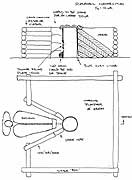On 11/03/13 4:38 PM, Scott wrote:
I've got an opportunity to make some beads and I'm trying to find
historical info on sword beads... and their use on scabbards. Have you
found anything relevant to this?
General readers might have seen that the other major experimental archaeology project (besides iron smelting)
DARC has been working
with is
glass bead making. Most specifically as an experimental
archaeology process, attempting to figure out how VA furnaces would have
been constructed and function. see :
http://www.darkcompany.ca/beads/index.php
(Readers might also want to troll this blog - search 'glass bead')
Although I do have some understanding of small charcoal fires, I thought
it valuable to learn how to actually make beads as well. So I invested
in a half decent oxy / propane torch (a home built by
David Robertson) and a pile of glass,
built a simple annealer. I've made maybe 150 - 200 beads at this point.
Not a huge number, but enough at least have some idea of the basic
processes.
 |
| Some modern patterned torch made glass beads, about 1.5 cm diameter |
I was interested (from some time back) in the 'sword bead' references.
I can also only remember some pretty vague second hand descriptions. These from back in
my SCA days, when solid documentation was hardly the norm.
I think I may have come across the references in 'the Sword in Anglo
Saxon England' by Ellisson (Davidson?). I've got it here someplace and
may try to find the correct citation later.
What I remember is this:
That there was a custom in Saxon times to fix a 'touch stone' to the
sword. These were often unusual shaped or coloured stones, often with a
natural hole in them. A lace would secure this stone to the scabbard or
hilt of the sword. The thought was that the stone would draw the poison
out of any wound inflicted by the blade. If you cut yourself sharpening,
you had ready access to the stone. An enemy would most certainly not. So
even a superficial cut would fester and perhaps even kill your enemy
after the fact.
This might not be too big a stretch on observed reality for the time.
With no understanding of germs and disease, and the regular process of
tightly binding a wound (to keep evil 'vapours' out) - gas gangrene
would be a common occurrence.
The specially made glass sword bead is then an extension of this
practice into a man made object.
I think I may have seen a single artifact object at some point (failing
memory!) which was described as a 'sword bead'. Given that the average
Viking Age glass bead is closer to 1 cm in diameter (or less), a larger and ornate
glass bead found in a male burial - close to the position of the sword
(ie waist), would be a obvious thing.
I got the following on a Google search
:
From the
British Museum
Background - C 600
England - Anglo Saxon
Description - Green glass sword-bead, drum-shaped.
Dimensions
-Diameter: 2.1 centimetres
(no image included)
From the
British Museum
Background - 4th - 5th Century - Ukraine (Hun?)
Description
- Chalcedony sword-bead; disc plano-convex section; central perforation.
A more random search will yield :
http://www.tillermanbeads.co.uk/
Tilerman Beads, the pieces are his modern replicas, he does
quote the individual sources however.
Sword Bead - Howletts - Grave 20
£7.00

A cylindrical translucent green bead with vertical ribbing on the
sides. Dated to the 6th century, found with a sword and a gilt bronze
buckle.
I *think* this is
Mike Poole's replica of the first bead referenced above from the British Museum. He does list a number of other 'sword bead' replicas on both his web site and Facebook pages.





























